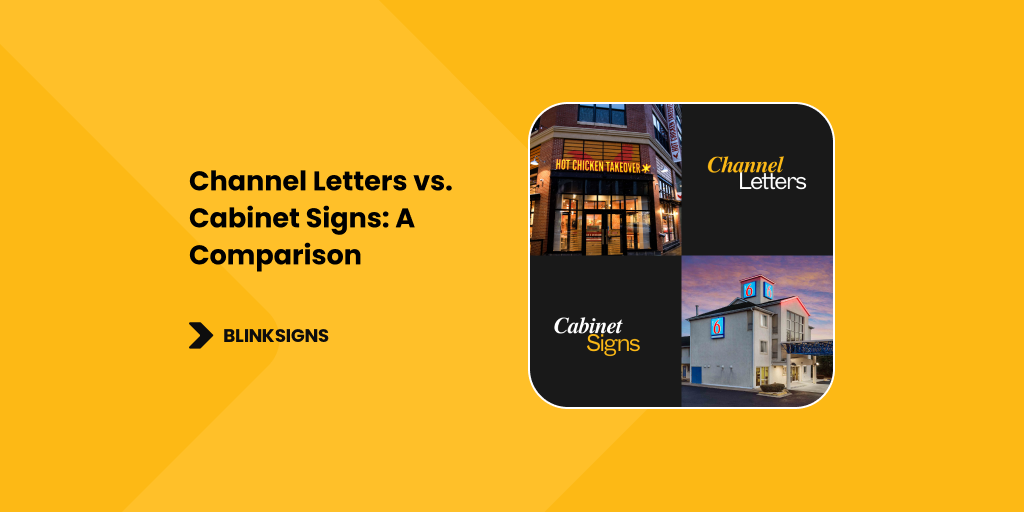
Channel Letters vs Cabinet Signs: Which Is Right for Your Business?
Signage remains one of the most critical business assets, serving as a powerful marketing tool and a key component of brand visibility. Channel letters and Cabinet signs are among the most popular choices for commercial signage, each offering distinct advantages and aesthetic impacts. Retail, hospitality, and service business owners often choose between these types, depending on specific goals like foot traffic attraction, visibility, and brand differentiation.
This guide will navigate the fundamental aspects of both types of signage, providing insight into their functionality, cost-effectiveness, durability, and compliance requirements. With a complete understanding of Channel Letters vs Cabinet Signs, businesses can make informed choices that align with brand identity, local regulations, and consumer engagement strategies.
What Are Channel Letters?
Channel letters are three-dimensional signs of individual letters, symbols, or numbers. Each letter is typically fabricated with durable materials like aluminum for the back and sides, with a translucent acrylic or polycarbonate face that can be illuminated. Used by various businesses, from shopping centers to office buildings, channel letters achieve a professional look, enhancing brand appeal and offering 24/7 visibility.
Types of Channel Letters
- Front-Lit Channel Letters: These channel letters emit light from the front, creating a bold and evident effect, especially at night.
- Back-Lit (Halo-Lit) Channel Letters: These letters project light around their edges, creating a subtle glow or halo effect that adds sophistication and depth.
- Open-Face Channel Letters: Designed to reveal the lighting source, these are typically illuminated with neon, lending a retro, eye-catching aesthetic.
- Raceway vs. Flush Mounting Options: Letters can be installed on raceways—a casing that houses electrical components—or flush-mounted directly on the wall for a more integrated look.
Common Materials Used
Channel letters are generally constructed from lightweight, corrosion-resistant aluminum and acrylic, chosen for their longevity and weather-resistant properties. For added durability, some designs incorporate polycarbonate, which offers enhanced resistance against impact and UV exposure.
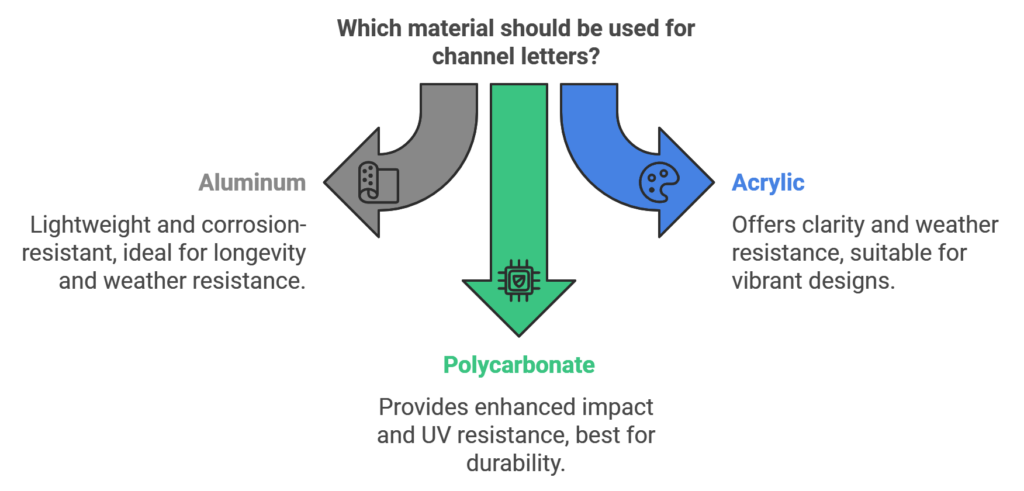
materials for Chennel Letters
Lighting Options
LED lighting is most commonly used, offering energy efficiency, versatility in color, and reduced maintenance needs. However, neon lighting is preferred for businesses aiming for a vintage look. LED channel letters consume less power, supporting sustainability goals and lowering operational costs.
What Are Cabinet Signs?
Cabinet or box signs are typically larger signs that house all the lettering or graphics within one enclosure. Unlike channel letters, cabinet signs feature a single, often rectangular structure that can display complex designs, logos, or graphics. Positioned on walls, poles, or as freestanding signs, cabinet signs cater to businesses that need maximum visibility, particularly those near high-traffic areas.
Types of Cabinet Signs
- Single-Face and Double-Face Signs: Single-face signs display content on one side and are suitable for wall mounting, while double-face signs increase visibility from multiple directions.
- Pylon and Monument Signs: Freestanding and tall, pylon and monument signs are ideal for locations near highways or roads, capturing attention from a distance.
- Wall-Mounted vs. Free-Standing: Wall-mounted cabinet signs attach directly to a building’s exterior, while free-standing signs are supported by poles or pylons, allowing flexibility in placement.
Materials Used in Cabinet Signs
Cabinet signs often use sturdy materials like aluminum for frames, while polycarbonate or vinyl faces are common for the sign’s surface. These materials offer durability and weather resistance, enabling the signs to withstand extreme weather conditions and UV exposure, making them ideal for long-term outdoor installations.
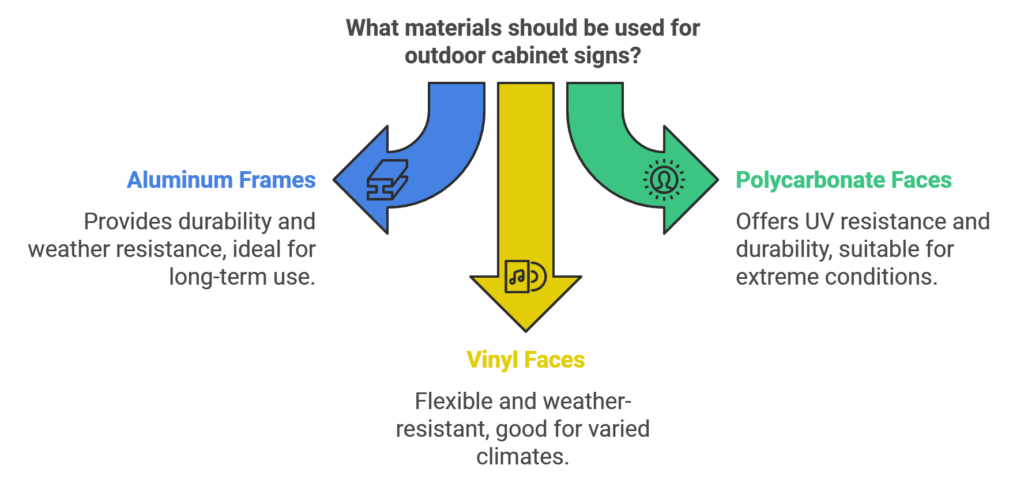
materials for Cabinet Signs
Lighting Options for Cabinet Signs
LED backlighting or edge lighting are typically used in cabinet signs to provide uniform illumination across the entire surface. This makes them highly visible at night, which is ideal for businesses wanting to attract customers during late hours. The lighting within a cabinet sign offers energy efficiency and consistent brightness, enhancing the impact of logos and graphics.
Key Differences Between Channel Letters and Cabinet Signs
Design and Visual Appeal
Channel letters offer a sleek, modern appearance that enhances brand professionalism and allows businesses to use standalone letters or symbols. Cabinet signs provide a larger surface, making them better suited for businesses requiring logo representation, intricate graphics, or additional textual information. For example, a law firm may prefer the clean sophistication of channel letters, whereas a restaurant may find that cabinet signs offer a better canvas for colorful logos.
Materials and Durability
Channel letters rely on materials like aluminum and acrylic, which are lightweight, corrosion-resistant, and long-lasting, particularly for exterior signage. Cabinet signs, often built from reinforced aluminum and polycarbonate, provide enhanced durability, especially in extreme weather conditions, making them suitable for businesses in high-exposure areas.
Lighting and Illumination
Both signage types incorporate LED lighting, but channel letters provide more directional illumination, highlighting each sign element. In contrast, cabinet signs offer widespread illumination across a larger canvas, ensuring uniform visibility for logos, graphics, and additional design elements.
Installation and Mounting
Channel letters are often flush-mounted or raceway-mounted based on architectural needs and desired aesthetics. Raceway mounting, which encloses all wiring, simplifies installation but may detract slightly from the aesthetic. Cabinet signs, however, are more flexible in placement and can be mounted on walls, poles, or as standalone pylon structures, providing visibility from various angles and distances.
Cost and Maintenance
Channel letters may incur higher initial costs due to customization, materials, and installation needs, but they generally require minimal maintenance over time. Cabinet signs, often more affordable initially, may need frequent maintenance, especially for freestanding structures or those exposed to harsh weather conditions. Businesses should consider these long-term costs alongside upfront investment.
Here’s a detailed table:
| Feature | Channel Letters | Cabinet Signs |
| Definition | Individual three-dimensional letters, symbols, or numbers are mounted separately. | Enclosed is a box-style sign displaying all Text and graphics within a single structure. |
| Design Style | Sleek and modern, with standalone letters that create a professional appearance. | Bold and versatile, often used for displaying logos, graphics, and text together on a large canvas. |
| Types | Front-Lit, Back-Lit (Halo-Lit), Open Face, Flush or Raceway Mounted | Single-Face, Double-Face, Pylon, Monument, Wall-Mounted, and Freestanding options. |
| Common Materials | Aluminum is used for structure, and acrylic or polycarbonate is used for letter faces. | Aluminum frames with polycarbonate or vinyl faces for durability. |
| Lighting Options | LED or neon, with options for internal and edge lighting; often used for evening visibility. | LED backlighting is primarily used for uniform illumination across the entire sign’s face. |
| Mounting Options | Flush-mounted directly to the wall or raceway-mounted with enclosed wiring for a cleaner look. | Wall-mounted, pole-mounted, or freestanding on pylons for high-traffic or roadside visibility. |
| Visibility Impact | Emphasizes each letter or symbol individually, creating distinct branding. | Provides extensive visibility with large surfaces suitable for logos, Text, and graphics. |
| Durability | Constructed with weather-resistant materials; lower maintenance due to separate letter design. | It is suitable for high-exposure and extreme environments and is made to withstand harsh weather with reinforced frames. |
| Ideal Locations | Office buildings, upscale retail stores, corporate headquarters, and indoor malls. | Shopping centers, roadside businesses, gas stations, and locations needing high visibility from a distance. |
| Regulatory Compliance | Must adhere to city building codes, ADA standards, and zoning ordinances for size and illumination. | Requires compliance with local signage codes, especially for more prominent signs near highways and zoning regulations for placement. |
| Cost Considerations | Higher upfront cost due to customization and materials; generally lower maintenance costs. | Initial costs can be lower, but more prominent signs, primarily if freestanding, may incur higher maintenance costs. |
| Maintenance Needs | Minimal due to individual letter design; requires occasional cleaning and LED/neon replacement. | Regular illumination, frame integrity, and cleaning inspections are required to retain brightness and durability. |
| Return on Investment (ROI) | Provides high ROI with brand distinction and professional appeal; attractive to upscale brands. | High ROI for locations needing broad visibility and brand reinforcement, ideal for retail and high-traffic roadside businesses. |
Compliance and Regulatory Considerations
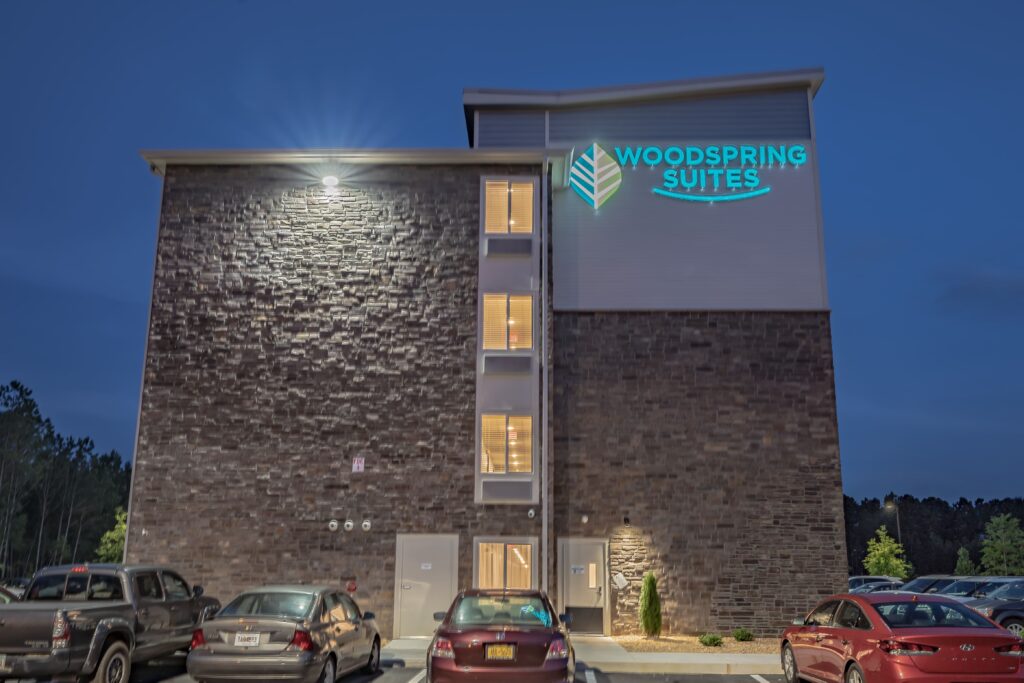
Woodspring Suites
Permits and Zoning Regulations
Obtaining a permit for exterior signage, especially illuminated or large structures, is often mandatory. This ensures signs meet safety standards and aesthetic guidelines. Compliance with zoning ordinances for each signage type is crucial to avoid penalties. Municipal codes frequently dictate the placement, size, and illumination settings for channel letters and cabinet signs, helping maintain city aesthetics and safety.
Building Codes and ADA Compliance
Channel letters and cabinet signs must meet local building codes and ADA requirements, particularly in public areas or businesses frequented by people with disabilities. The ADA mandates certain characteristics in signs, such as readability and non-glare finishes, ensuring accessibility for all individuals.
Illumination and Environmental Restrictions
City regulations on illumination aim to prevent excessive brightness, especially near residential areas, to reduce light pollution. Channel letters and cabinet signs may face restrictions regarding operating hours, brightness levels, and size, as well as supporting community standards and environmental goals.
Cost Analysis and Investment Considerations
Initial Costs
Due to their material requirements and customization, channel letters are often associated with higher initial costs than cabinet signs. The level of customization, size, and mounting requirements contribute to the cost variance. Cabinet signs can be cost-effective for businesses needing broad visibility but may require greater upfront investment for freestanding installations.
Long-Term Costs and Maintenance
While channel letters generally require less maintenance, thanks to their weather-resistant materials and design, cabinet signs may demand more upkeep, especially in regions with extreme weather exposure. Routine inspections, repairs, and cleaning can increase long-term costs, so businesses should account for these expenses in their budgets.
Return on Investment (ROI)
Channel letters deliver high ROI by projecting a professional brand image, appealing to upscale businesses like financial services and boutiques. Cabinet signs, which provide broader visibility and accommodate larger graphics, offer solid ROI for businesses in highly competitive or high-traffic areas, such as retail stores and restaurants.
Design and Customization Options
Customization for Brand Consistency
Channel letters and cabinet signs offer extensive customization options, enabling businesses to match signage with brand colors, fonts, and design elements. Channel letters deliver a minimalistic, clean aesthetic ideal to professional firms, while cabinet signs allow a more expansive display for vibrant logos and visuals, enhancing brand storytelling.
Visual Elements for Impact
Effective signage demands careful attention to legibility, color contrast, font size, and visibility. Channel letters excel in bold lettering, ideal for building a sophisticated brand presence. At the same time, cabinet signs provide ample space for logos and intricate visuals, capturing the attention of a diverse audience.
Maintenance and Durability Requirements
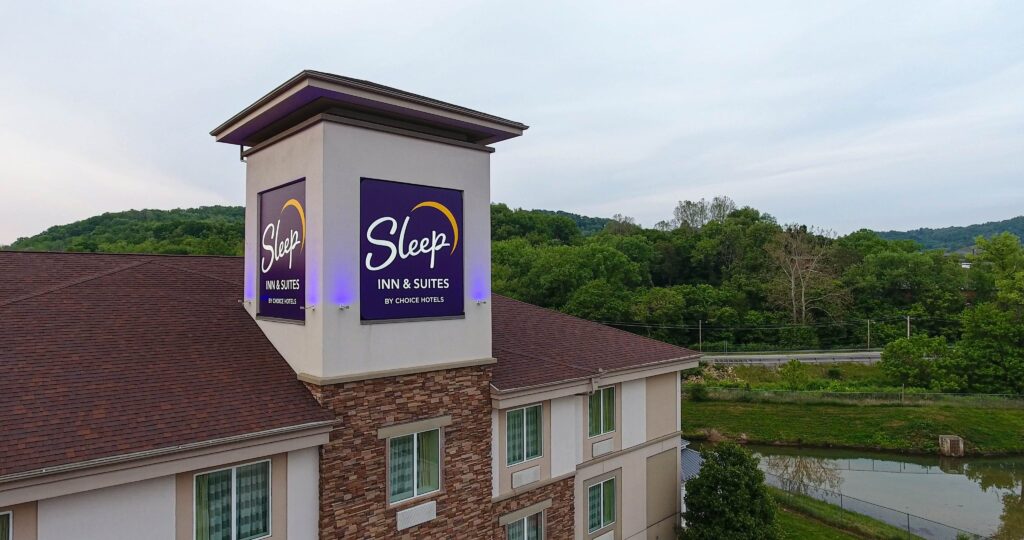
Sleep Inn and Suites Signage
Routine Maintenance
Channel letters are low-maintenance due to their durable materials, often requiring only occasional cleaning and light bulb replacement. Cabinet signs, especially when installed in exposed locations, may demand more frequent upkeep to retain clarity and brightness.
Durability Factors
Channel letters made from aluminum and acrylic resist harsh weather conditions, making them ideal for outdoor environments. Cabinet signs, constructed with weatherproof frames and reinforced exteriors, offer durability that suits high-traffic areas, particularly when enhanced with UV protection and anti-corrosion finishes.
Common Repair Needs
Both signage types may require occasional lighting and structural repairs, especially illuminated signs with LED or neon elements. Periodic checks ensure the signage remains visually compelling and functional, supporting brand image and ensuring compliance.
Environmental and Sustainability Considerations
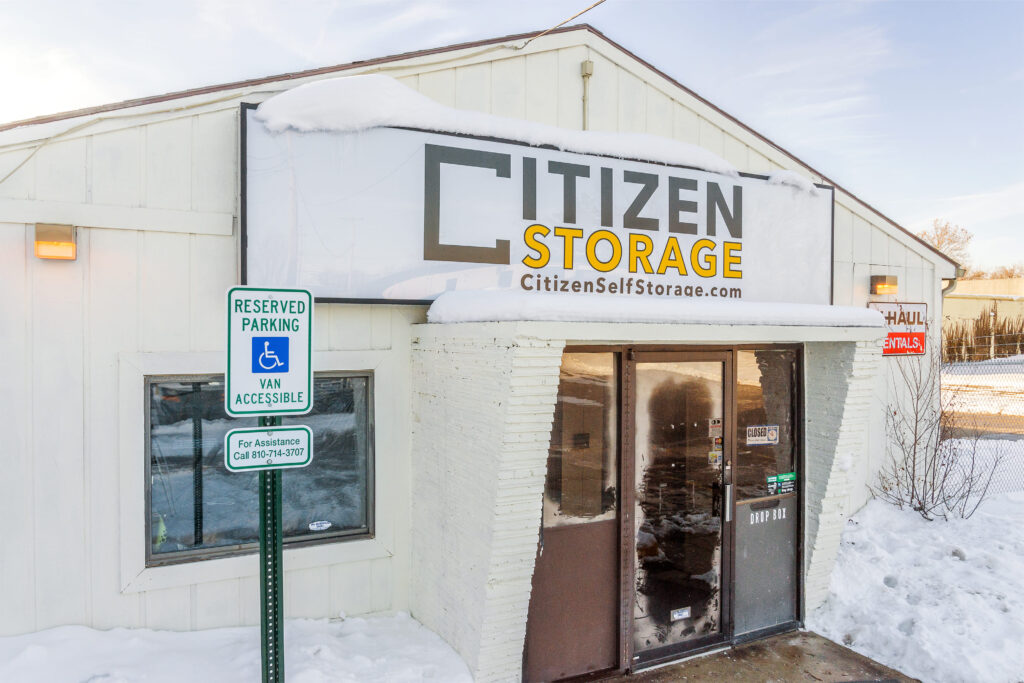
citizen-storage Signage
Eco-Friendly Material Choices
Channel letters and cabinet signs can be fabricated from recyclable materials like aluminum and polycarbonate for environmentally-conscious businesses. This helps reduce environmental impact while promoting sustainability in business operations.
Energy-Efficient Lighting
LED lighting not only reduces energy use but also supports sustainable branding. LED lights in both signage types provide consistent brightness and cost-effective operation, aligning with eco-friendly practices and reducing operational expenses.
Compliance with Local Environmental Regulations
Environmental regulations increasingly influence signage, especially in residential areas with light pollution ordinances. Channel letters and cabinet signs should adhere to these guidelines, ensuring signs benefit the business without compromising community standards.
Interactive and Technological Enhancements
Digital and Smart Signage Integration
Both signage types can integrate digital technology, such as interactive screens or QR codes, which enhance customer engagement and allow businesses to update content regularly. These features create a dynamic signage experience, elevating brand interaction.
Augmented Reality (AR) and QR Codes
Channel letters and cabinet signs may incorporate QR codes or augmented reality elements to connect customers with digital content, like product promotions or social media, creating a seamless transition between physical and digital brand experiences.
FAQs
How do cabinet signs differ from other types of signage?
Cabinet or box signs feature an enclosed structure where graphics and text are displayed on one surface. BlinkSigns recommends cabinet signs for their versatility and bold visual impact, especially for roadside visibility.
Which signage type is more durable for outdoor environments: channel letters or cabinet signs?
Both options are built for durability, but channel letters often withstand weather better due to individual mounting, while cabinet signs excel in high-traffic areas. BlinkSigns ensures both options use weather-resistant materials for longevity.
Are channel letters suitable for all types of businesses?
Yes, channel letters are versatile and work well for various industries, especially retail, corporate offices, and storefronts where visibility and branding are essential. BlinkSigns tailors each set of channel letters to suit brand aesthetics and location.
How does BlinkSigns help with signage compliance and permits for channel letters and cabinet signs?
BlinkSigns navigates the permitting process, ensuring compliance with local codes for both signage types. Our team handles zoning, ADA requirements, and illumination regulations, streamlining approval for every project.
Can LED lighting be added to both channel letters and cabinet signs?
Absolutely. BlinkSigns offers LED lighting options for channel letters and cabinet signs, enhancing visibility and energy efficiency. LED illumination is effective in drawing attention and creating a professional look.
What are the maintenance requirements for channel letters and cabinet signs?
Channel letters typically require less maintenance due to individual letter mounts, while cabinet signs may need periodic lighting and frame stability checks. BlinkSigns offers maintenance services to keep signage looking pristine.
How do you choose between front-lit and back-lit channel letters?
Front-lit channel letters highlight the letter face, making them highly visible, while back-lit (halo-lit) letters create a softer, more sophisticated glow around them. BlinkSigns can guide you to the best option based on brand style and location.
Can I customize the color and design of cabinet signs with BlinkSigns?
Yes, cabinet signs are highly customizable. BlinkSigns can incorporate brand colors, unique fonts, and even logo graphics into the sign’s face, creating a bold and cohesive look for your business.
Which type of signage, channel letters or cabinet signs, provides a better ROI?
Both offer strong ROI but in different ways. Channel letters enhance upscale brand appeal, while cabinet signs offer wide-reaching visibility, especially for roadside businesses. BlinkSigns helps determine the best choice based on your location and audience.
Conclusion: Choosing the Right Signage for Your Business
Selecting the right signage is crucial in establishing a brand presence and reaching potential customers. Channel letters create a modern, professional aesthetic, ideal for upscale businesses, while cabinet signs deliver impact and visibility for brands in high-traffic areas.
BlinkSigns offers expertise in channel letters and cabinet signs, helping businesses navigate design, installation, and compliance. Together, we ensure every sign maximizes brand appeal, aligns with local codes, and supports long-term success. Contact us at Sales@blinksigns.com for more details and let us leverage your business to the new hights.